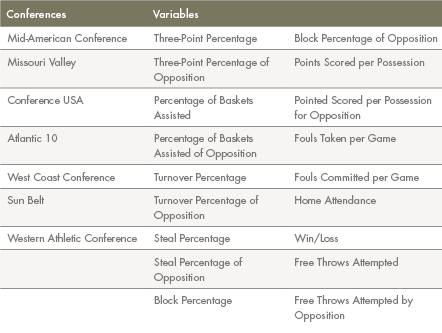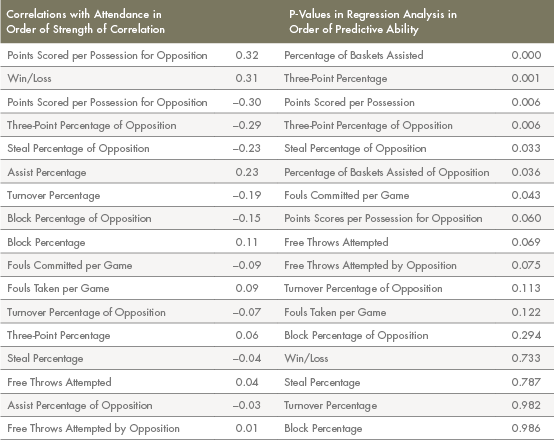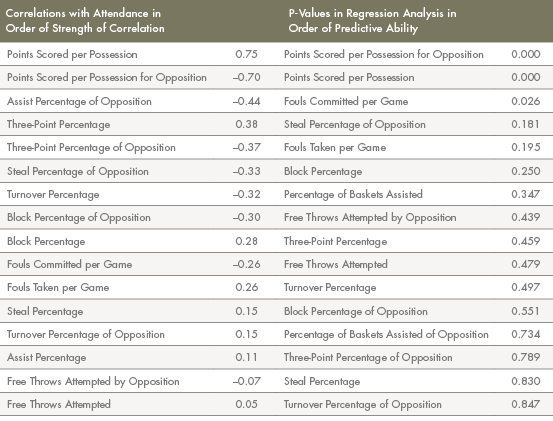In the absence of having one of the top basketball programs in the nation, filling the seats for a college basketball game can be relatively difficult. Despite the fact that the public measures performance of college basketball programs by the success of the team on the court, what is often of more importance to the institutions is the ability for the team to generate profitable attendance figures. While studies have been done in basketball about characteristics of gameplay that predict success on the court, there is very little information about factors that drive attendance at basketball games. This study will look at aspects of gameplay that have predictive value in ticket sales, consider those same aspects in relation to excellence on the court, and compare the results to see if certain styles of play are consistent with success both on the court and in the box office.
This study looked at 77 teams in NCAA Division I basketball from the 2009-2010 season during conference play and extracted aspects of gameplay that indicate the style of play the teams employed. These non– automatic-qualifying conferences were chosen because they have teams that play basketball at a high level of competitiveness, but do not consistently sell out home games, which would distort the results of this study. By looking at variables such as points per possession, three-point percentage, assist percentage, and fouls per game for each specific team, a reasonable amount of data was included in order to suggest the type of basketball each team played. Ratios were chosen instead of an absolute amount in order to avoid redundancy and preserve the integrity of the data by avoiding dependency of variables upon each other. For example, while the number of assists is directly related to points per possession (as assists per game increases, so does points per possession), the same is not true of assist percentage and points per possession (additional points can be scored without being assisted). Different philosophies that could be expected are teams that choose to emphasize either offensive or defensive efficiency, teams that focus on shooting three-pointers with a high level of effectiveness, and teams that are disciplined in their ability to avoid fouls. Table 1 shows conference affiliations of the 77 teams that were included in the study and a list of the variables used to determine style of play.
Table 1 — Study Breakdown: Conference Affiliations and Independent Variables Determining Style of Play

When a head coaching decision for a basketball team needs to be made, on-court strategy is probably not the first consideration that comes to mind. Intuition indicates to most people that a winning team is the best way to get fans to attend the games, and there certainly is some truth to that notion. However, the results of the study show that while the percentage of games won does have a strong positive correlation with attendance, it is not the biggest motivating factor for fans that attend games. Instead, the four main factors associated with predicting attendance are assist percentage, three-point percentage, three-point percentage allowed for the opposition, and points scored per possession. The correlations between the independent variables and attendance, as well as their significance in a regression equation predicting attendance, are listed in table 2.
Before we proceed, we would like to point out three things that are important in deciphering the results of the current analysis. First, while most of us are familiar with correlation, significance data from regression equations are often comprehended to a lesser degree. For the majority of our analysis we will use the p-values from the regression analyses as our primary indicators of what variables are significant. 1 Second, when we perform a regression analysis, we can identify how much of attendance is explained by the 17 variables listed in table 1. In this case the variables predict 34.1% of attendance, which is relatively low yet expected because of the lack of strength of correlation between the variables and attendance. Third, the natural log of all variables in our attendance regression analysis was taken in order to account for attendance that changed exponentially from team to team.
Table 2 — Correlation between Independent Variables and Attendance

Using the same variables, we substituted win/loss percentage for attendance to see how these variables correlate and predict the success of a team on the court. The three main gameplay variables that are associated with winning games are points per possession, points per possession allowed for the opposition, and fouls committed per game. The correlations between the independent variables and win/loss percentage, as well as their significance in a regression equation predicting win/loss percentage, are listed in table 3.
These results make more immediate sense to us due in large part to a better a priori understanding of what drives success in gameplay. The results of this study are also consistent with other studies that have considered success on the court in basketball. The most elementary concept of basketball is the team that scores more points than the other will win the game. However, while basketball can essentially be boiled down to such a simple equation, understanding what drives success at the box office is much more complex and sophisticated. Our regression analysis is able to tell us this as well, with our 16 variables predicting 86.1% of what helps basketball teams win. This is significantly higher than the 34.1% seen in our attendance model, and is expected due to the significant increase in correlation between the variables and win/loss percentage. This makes perfect sense, because the success of a team is almost exclusively dependent on gameplay variables such as the 16 used in this study, whereas attendance is also likely affected by numerous other variables such as weather and the quality of opponent being played.
With the results of the analyses stated, let’s move on to comparing the results and considering the implications of the study. There are four conclusions that we would like to note in regards to the analyses:
Table 3 — Correlation between Independent Variables and Win/Loss Percentage

1. Neither offensive nor defensive statistics stand out as clear indications of what helps a team win games, but three of the top four factors associated with attendance are offensive statistics. This likely means that conference wins can be achieved by multiple means, while fans tend to prefer a team that can light up the scoreboard over a team that is stout on defense. This makes sense, as defensive battles can sometimes be perceived as less entertaining games to watch.
2. The most significant predictors of attendance are percentage of baskets assisted, three-point percentage, and points scored per possession. While there is not a clear-cut answer to a certain strategy or style of play that is conducive to attracting fans by looking at these data, a case could be made for teams that distribute the ball well and shoot effectively from the three-point line, resulting in a high amount of points per possession. The fact that assist percentage and assist percentage allowed are both highly predictive for attendance could indicate that fans appreciate teams that play as such rather than teams that emphasize individual performances on offense.
3. In terms of success on the court, having effective scoring and preventing opposing teams from scoring are predictors that we knew would top the list (the 0.00 p-values imply there is 0% chance that these variables do not predict success). Additionally, the low p-value for fouls committed per game may indicate that having key players in foul trouble is important to avoid.
4.Contrary to traditional assumptions, fans care little about the win/loss percentage of the team. In fact, when looking at the p-values of the attendance analysis, we see that win/loss percentage is the fourth-worst variable at predicting attendance. Despite the fact that it tends to correlate well with attendance, it does not have any predictive ability in determining whether fans are more likely to attend games. 2
Key Insights
There is not an obvious style of play that stands out from these variables that consistently leads to success at the box office or on the court. However, we can say that limiting fouls committed per game is important in predicting both attendance and wins with 95% confidence. This could be the result of a poor team needing to foul often to stop the opposing team, key players accumulating fouls that keep them out of the game, or a mixture of the two.
References:
- In particular, some might assume from the correlations that win/loss percentage and points per possession are two of the three variables most associated with attendance. However, it is important to understand what statistical regression can tell us that correlation cannot. Without delving far into statistical techniques, correlation merely quantifies how well two variables relate to each other, while regression creates a linear equation that can determine how well variables such as win/loss percentage actually predict attendance. The lower the p-value, the better job the statistic does of explaining either attendance or win/loss percentage. ↩
- This result initially surprised us since it challenged suppositions that we entered the analyses with. However, even in further attempts to isolate this variable, we found the same results to be true. We conducted additional regression analyses on attendance data with only seven variables out of the 17 that correlated well with attendance, one of which was win/loss percentage. By eliminating other variables that do not correlate well, it is possible to eliminate some noise from the equation and better attribute predictive ability to individual variables. The variables we used were three point percentage allowed, assist percentage, turnover percentage, steal percentage of the opposition, points per possession, points per possession allowed, and win/loss percentage. Nevertheless, the results of this analysis were the same as the results displayed above. ↩




